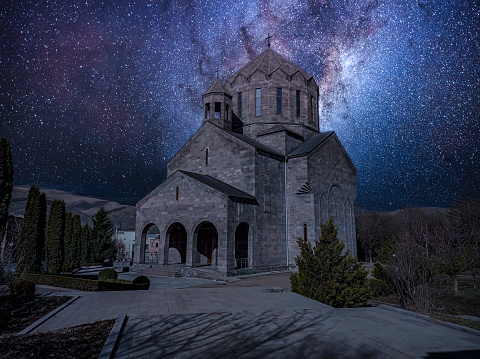Armenia, the first country to designate Christianity as its national religion, has some of Europe’s most beautiful scenery, with Mount Ararat dominating the country’s skyline. Despite the fact that its top lies just across the Turkish border, Ararat is considered holy by locals since it is where Noah’s Ark landed.Yerevan, the capital of Armenia, is one of Europe’s most rapidly expanding cities.
1. Yerevan

The capital of Armenia, Yerevan, is by far the largest city and an excellent spot to begin seeing the country. The city’s grand Republic Square is a must-see, as is climbing the Cascade to witness the city’s monument commemorating the Soviet triumph in WWII. Yerevan is a historically significant city, and visiting the Armenian Genocide Memorial is a must for those interested in learning more about the country’s turbulent past. A trek into the Hrazdan gorge is also highly recommended, as is the Vernissage flea market, which is open on weekends. Day tours from Yerevan, also known as the City of Cafes, allow visitors to see much of what Armenia has to offer. Yerevan is also the capital.
2. Shikahogh State Reserve

Shikahogh State Reserve, Armenia’s second largest forest reserve, is so unspoilt that huge portions of it remain untouched to this day. Leopards, bears, wild goats, and vipers are thought to live in the forest, and Shikahogh State Reserve is considered to have around 1,100 plant species, though its wildlife has not yet been thoroughly studied. In 2005, a planned motorway threatened the reserve, but environmentalists successfully pushed for the forest’s future to be saved. A variety of stunning waterfalls can also be seen within the reserve.
3. Lake Sevan

The country’s largest lake, Lake Sevan, is located in the centre of Armenia and is a lovely destination to visit during a vacation there. The lake is surrounded by several monasteries, the most spectacular of which is perhaps the Sevanavank Monastery, which provide a beautiful panoramic backdrop for a pleasant journey. Windsurfing is one of the lake’s recreational activities, and the lake’s shoreline is lined with outstanding seafood eateries. Because Armenia lacks a coastline, Lake Sevan has a variety of famous beaches, making it the greatest site in the country to sunbathe, with Sevan Bay and its surrounding mountains providing stunning views.
4. Dilijan national park

Armenia has four national parks, with Dilijan National Park possibly being the most picturesque of the bunch. The park, which opened in 2002, is known for its medical mineral springs and natural landmarks. Many of Armenia’s most prominent cultural sites, including Haghartsin Monastery, Goshavank Monastery, and Jukhtak Vank, as well as Matosavank Monastery and the Akhnabat church, are located within the park’s boundaries. The Aghestev and Getik river basins are also inside the Dilijan national park’s limits.
5. Mount Aragats

Mount Aragats, a dormant volcano in Armenia’s north, is one of the country’s most beautiful natural wonders. It is Armenia’s highest peak, and the area at its base is rich in rock art, including drawings of animals and human-like forms dating back hundreds of years. Mount Aragats is snow-covered practically all year, but it may be climbed, with July, August, and September being the ideal months to do so. The simplest of the four summits to climb is the southernmost, while the northern peak, at roughly 4,000 metres, is the most difficult.
6. Lake Arpi

During the peak tourist season, Lake Sevan can be highly busy, whereas Lake Arpi has a considerably more tranquil atmosphere. Lake Arpi is the source of the Akhurian River and is used for irrigation and hydropower generation. With about 100 kinds of birds known to live in the vicinity, a new park was constructed around the lake in 2009 to safeguard the natural environment. Lake Arpi is also a Ramsar Convention protected site with abundant vegetation and animals. Lake Arpi is home to one of the greatest colonies of Armenian Gulls, as well as camping and walking tours.
7. Noravank

One of Armenia’s distinguishing qualities is its monasteries, and the one at Noravank is one of the most magnificent in the country. The monastery, which was established in the 13th century, is protected by sheer brick-red cliffs. Noravank is known for its Astvatsatsin (Holy Mother of God) church, which is said to have been saved by God himself when Armenia was overrun by the Mongols centuries ago. If you just visit one monastery during your vacation to Armenia, Noravank would be a great choice — thousands of people visit each year.
8. Gyumri

Gyumri, Armenia’s second largest city, is definitely worth a visit for anyone visiting the nation for the first time. The Black Fortress on the hill that overlooks the city is perhaps the best site to take in the scenery of Gyumri, while the gigantic Mother Armenia statue is also close. The Dzitoghtsyan Museum of Social Life and National Architecture of Gyumri, as well as the Aslamazyan Sisters House-Museum and the Sergey Merkurov House-Museum, are among Armenia’s most notable cultural institutions. The Kumayri Historic District is Gyumri’s oldest neighbourhood, with over a thousand historic structures.
9. Vanadzor

Vanadzor, Armenia’s third largest city, is located in the country’s northwestern region. Vanadzor is an excellent base for seeing Armenia’s gorgeous Lori region, which is unquestionably one of the best places to visit. The Vanadzor Botanical Garden is one of the city’s most popular tourist attractions, and visitors can also visit the Vanadzor Fine Art Museum. The Lori region’s various mineral springs have resulted in a wide selection of fantastic spas in and around Vanadzor. Vanadzor is predominantly an industrial city, but it also has a number of theatres, including the Vanadzor Chamber Theatre and the Vanadzor Puppet Theatre.
10. Amberd Fortress

Amberd Fortress, which dates from the seventh century, is one of Armenia’s most beautiful destinations. The fortress, which was formerly one of the Armenian Kingdom’s key military-defensive positions, is about an hour’s drive from Yerevan, the capital city. During the winter months, however, snowfall can make the stronghold inaccessible, but the weather normally improves by late May. The view from the top of the fortress is amazing, and the structure itself is equally impressive. Amberd Fortress is within a short distance from Byurakan Village, which is home to the Byurakan Observatory.
11. Tsaghkadzor

Armenia’s hilly terrain is perfect for winter sports, and Tsaghkadzor, in the country’s core, is home to the country’s best ski resort. The cost of a ski lift is determined by the number of people using it, and it is among the most economical in Europe. Tsaghkadzor has some of the best hotels in the country, as well as the Senator Royale casino complex, which is one of the country’s largest entertainment destinations. Tsaghkadzor also features the Kecharis Monastery, which dates from the beginning of the 11th century and is one of Armenia’s most prominent religious complexes.
12. Upper Azat Valley

The Upper Azat Valley is one of Armenia’s World Heritage Sites, thanks in part to the region’s most famous landmark, the Geghard Monastery. The great chapel was completed 800 years ago, but the monastery’s history dates back to the fourth century, when Gregory the Illuminator founded it. The Geghard Monastery, according to mythology, formerly contained one of the spears used to crucify Jesus Christ, which was delivered to Armenia by Apostle Thaddeus, and is thus one of Armenia’s most important holy sites. The chapel of St Astvatsatsin (Holy Mother of God) is partially carved out of the rock in the Upper Azat Valley.
13. Karahunj Observatory

Karahunj is one of the most fascinating spots to see while a break in Armenia, and is sometimes referred to as Armenia’s counterpart of Britain’s Stonehenge. Karahunj, near Sisian in the Syunik region, is home to around 200 large stone graves, with 40 standing in a circular configuration in the main area, allegedly created in honour of the Armenian major God, Ari, who is called after the Sun. A tiny museum in Sisian is dedicated to discoveries made at Karahunj, which claims to be the world’s oldest observatory of its sort.
14. Khor Virap

Mount Ararat can be seen from all throughout Armenia, but probably the best views of the peak can be seen from the Khor Virap monastery, which is well worth a visit in and of itself. This is one of Armenia’s most significant historical places since it was here that Gregory the Illuminator was imprisoned for 14 years before curing King Trdat III of his sickness. The King thereafter became a Christian, establishing the foundation for Armenia’s future religious development. As a result, Khor Virap is a favourite location for Armenian weddings today, and visitors can see the underground chamber where Gregory the Illuminator was imprisoned during a visit to Khor Virap, which is one of Armenia’s most frequented pilgrimage sites.
15. Dvin

Our final pick for the greatest locations to visit in Armenia is Dvin, one of the country’s oldest cities and, at one time, the country’s capital. According to Unesco, Dvin previously had a sixth-century BC castle, and magnificent artefacts are frequently discovered in this part of Armenia. The city also has more recent attractions, such as the St. Harutyun Church in Dvin, which was erected in 2000. The Cathedral of St. Grigor formerly stood in Dvin, but archaeologists have only discovered the stone foundations of the structure today.



